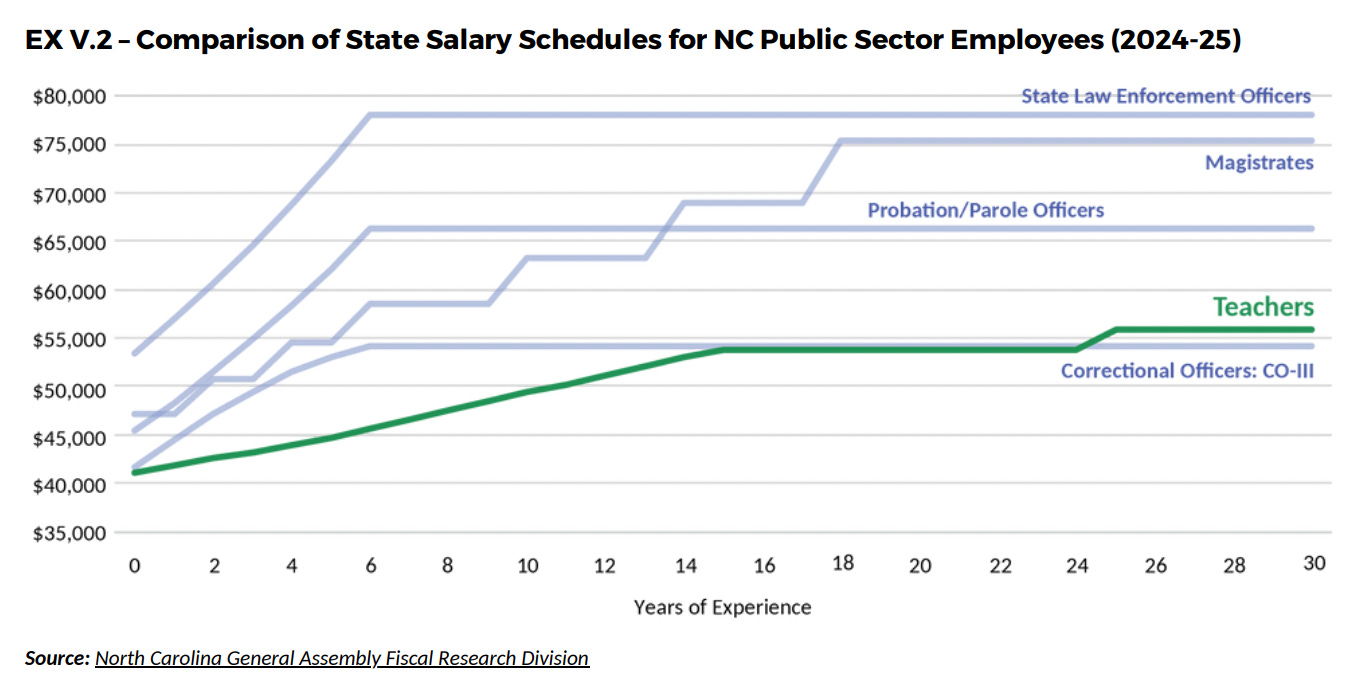My favorite way to look at teacher salaries
The "average" doesn't tell you very much
I sort of hate the “average” teacher salary statistic. It compresses too much information into one number.
In a district, if a veteran teacher retires and is replaced by a new beginner, the “average” salary will fall. If a district happens to have a lot of veterans, it might look like it has a high “average” salary even though all of its teachers earn less than their peers in another district nearby which pays higher salaries but just happens to have a younger workforce.
The average teacher salary has been remarkably flat, in inflation-adjusted terms, since about 1990. Meanwhile, schools employ a lot more teachers (overall and on a per-student basis) and teachers today have much less experience than the teacher workforce did back in 1990.
The average is hiding all of these trends.
A better way to look at teacher salaries is to look at the slope of the line. How much do teachers earn at the start of their career, and how fast do they earn increases over time? Do those increases actually align with what we know about teacher retention rates or the rate at which teachers improve on the job?
I’ve done this type of analysis for individual districts before (see here for a broad overview). But BEST NC has perhaps my favorite version in their recent report on teacher pay across North Carolina. Here’s the chart:
I like this way to look at teacher salaries. You can immediately see how teacher salaries compare to the salaries of other public-sector workers in North Carolina. (These are base salaries and don’t include additional local supplements, benefits, or other supplemental pay.) Teachers are doing much worse overall. They have the lowest starting salaries, and they have to serve longer to reach their full maximum pay.
You can also look closely at how teacher salaries grow over the course of a career. In North Carolina, with their current statewide salary schedule, teachers get small annual raises (not including cost-of-living adjustments) until year 15, then no raise until year 25 when they get a small bump.
This wage growth pattern does not match what we know about teachers. First, there’s evidence that young people are particularly sensitive to starting salaries. North Carolina is going to struggle to convince people to come into teaching when they can immediately make more doing something else. And these are public-sector comparisons! Starting salaries for college-educated workers in the private sector would probably be even higher.
Second, we also have good evidence that teacher performance improves rapidly in the first years on the job. There are different ways to look at it, and other research has found similar patterns for teacher observation ratings. But the BEST NC report features this graph showing value-added scores by experience level. As you can see, beginning teachers tend to be bad, but they improve rapidly over time to the point where teachers with 6-8 years of experience are virtually indistinguishable from those with much more experience. Remember, North Carolina’s salary schedule does not reflect these growth trajectories.
And third, North Carolina’s teacher salary schedule also doesn’t match up with its own retention problems. The BEST NC report also shows the turnover rates across North Carolina. The blue bars represent the annual turnover rates by experience level, and the green numbers show the actual number of people who leave during those years.
As you can see in the chart below, the highest turnover rates are for those closest to retirement, with 27 or more years of experience. But the highest turnover numbers, by far, are those who leave in their early years. (I’ve looked at these numbers for every state, and while the numbers and rates may vary, they ALL follow a similar trajectory.)
In other words, if policymakers want to improve their recruitment and retention numbers, they should focus on the left side of this graph, where they’re losing most of their teachers. That’s not reflected in North Carolina’s statewide salary schedule yet, but it could be, and looking at salaries this way can provide for a deeper understanding of problems and opportunities.






My nerd heart just leapt out of bed for this one. Thanks so much for all of the work you put into this.